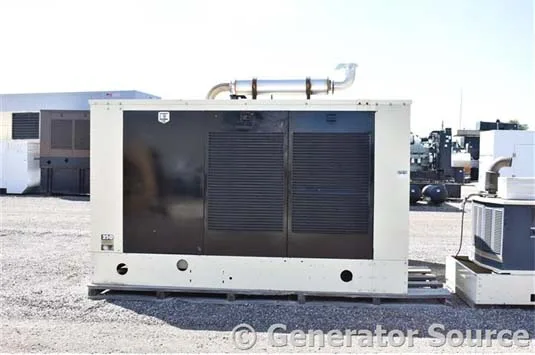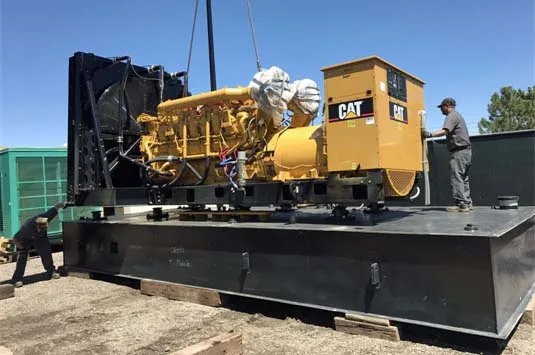Shipping industrial generators involves careful planning and management to ensure safe delivery from the vendor to the customer site. The logistics process covers securing the generator during transport, obtaining necessary permits, and unloading at the destination. Below, we explore logistics considerations for shipping three different types of industrial generators: Kohler 250 kW NG, Cummins 750 kW, and Caterpillar 2500 kW.

1. Kohler 250 kW NG
Type: Small industrial generator with a natural gas fuel supply.
Appeal: Chosen for environmental considerations, using natural gas as fuel.
Logistics Checklist:
- Securing and Protecting the Generator for Transport:
- Freight Agreement: Defines responsibility for safe passage during transport.
- Securing the Generator: The generator should be securely fastened to the truck using appropriate methods to prevent movement.
- Weatherproofing: A tarp should cover the generator to shield it from weather conditions during transport.
- Permits Needed for Transport:
- Identify any local, state, or federal regulations, including oversize load permits.
- Unloading the Generator Set at the Site:
- Prepare the site to minimize crane or forklift rental costs.
- Lifting Device: The type of lifting device (crane, forklift, etc.) depends on the site’s characteristics.
2. Cummins 750 kW
Type: Mid-size industrial generator with a diesel fuel supply.
Appeal: Replacing an outdated generator with a more efficient diesel option.
Logistics Checklist:
- Securing and Protecting the Generator for Transport:
- Freight Agreement: The agreement should clearly define how the generator will be safely transported.
- Protection Measures:
- Radiator/Intercooler Protection: Cooling fins can be easily damaged. A tarp provides basic protection, but plywood can be added for extra safeguarding before tarping.
- Control Panel Protection: The generator and control panels should be wrapped in industrial stretch or shrink wrap.
- Extreme Weather Protection: In harsh conditions, shrink wrap rated for transportation can be used to cover the entire generator.

- Permits Needed for Transport:
- Permits should be acquired based on the generator’s size, weight, and route.
- Unloading the Generator Set at the Site:
- The site must be equipped to receive the generator inside a machinery room.
- Site Features: An overhead door and a concrete pad in a gravel area, along with a gantry for unloading.
3. Caterpillar 2500 kW
Type: Large industrial generator with a diesel fuel supply.
Appeal: Chosen for its sound attenuated enclosure, large fuel tank capacity, and digital controls to meet facility needs.
Logistics Checklist:
- Securing and Protecting the Generator for Transport:
- Freight Agreement: Defines the responsibilities for ensuring safe transport.
- Generator Securing: Ensure the generator is properly secured to the truck.
- Protection Measures:
- Tarp: The generator should be covered with a tarp to protect it from the elements.
- Additional Considerations: Ensure all supporting devices like batteries are secured, and all doors are latched before tarping.
- Permits Needed for Transport:
- Obtain all necessary permits based on the generator’s weight and size.
- Unloading the Generator Set at the Site:
- The generator will be installed on a reinforced concrete pad with hardware prepared.
- Terrain Considerations: The terrain surrounding the pad must be suitable for the combined weight of the crane and generator.
Permits Needed for Transport
- Oversize Loads: Generator sets, especially large ones like the Caterpillar 2500 kW, may require disassembly or additional permits.
- State Regulations: Shipping routes often cross state lines, and each state has its own load size and weight regulations. For example, some states require permits for trailers with a drop greater than 1’6″, while others may restrict shipping times to weekdays or daytime hours only. It is crucial for the shipper to check the specific regulations of each state on the route to ensure compliance.

Additional Considerations
For all types of industrial generators, it’s important to be proactive in site preparation, securing and protecting the generators, and ensuring all necessary permits are acquired. Shipping larger generators requires special attention to their size and weight, especially if disassembly or additional weatherproofing measures are needed.

Conclusion: The logistics of shipping an industrial generator require careful planning to ensure that the generator is safely transported and unloaded at the site. Different types of generators, such as the Kohler 250 kW NG, Cummins 750 kW, and Caterpillar 2500 kW, have unique requirements depending on size, fuel type, and environmental considerations. Proper coordination with shipping brokers and site preparation is key to a successful delivery.